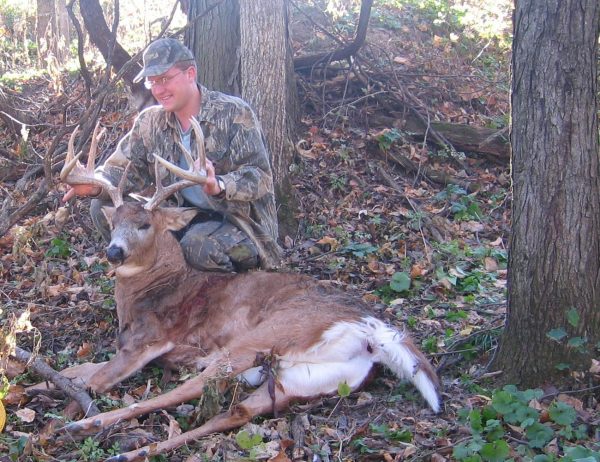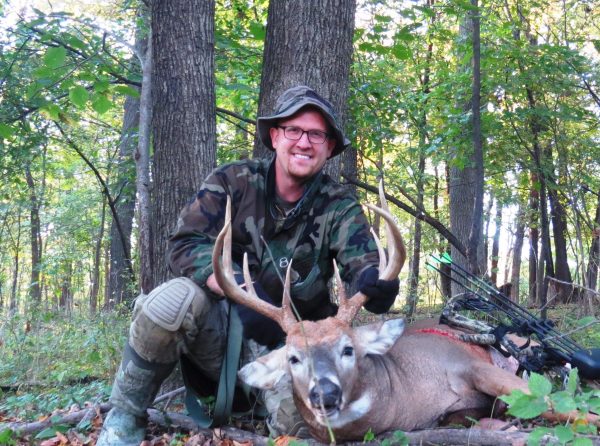
Earlier this spring on Wired To Hunt we profiled a seriously successful DIY public land bowhunter name Joe Elsinger in one of our Q&A blog posts. And what he had to share was so interesting that I then invited him to later join us as a guest on the podcast. As I figured it would be, that episode was jam-packed with helpful insights into targeting mature bucks. So naturally, I wanted more. And fortunately for us, we’re going to get just that. This is the first of what will hopefully be many guest posts from Joe here on Wired To Hunt. Enjoy. – MK
By Joe Elsinger
One topic often discussed on the Hunting Beast forum, which I frequent, is that of mobile hunting strategies for mature whitetail bucks. That is, the merits of packing in and out your entire setup and selecting a new spot for each hunt.
It has been suggested that the single most beneficial strategy change that Average Joe hunter could make is to pick a new setup with every hunt. I couldn’t agree more.
Every discussion of tactics is situational. There is a fundamental difference, not acknowledged often enough, between the hunters who must beat competition to harvest a deer on shared hunting land and the exclusive access hunter, who may be better served centering his or her efforts on luring deer into an exposed location.
This article is for the reality that most of us face; There are other hunters in our woods, and to succeed we must hunt a buck down.
We have all heard about world class whitetail bucks killed on a random hunt by a random meat hunter. We also have heard stories of the rookie kid, who gets pointed in a direction no one else wants to hunt and kills the biggest buck around. As a master of survival, how does a monster buck fall to a rookie?
I would say a common theme in these “lucky” kills is not acting like all other hunters. Perhaps there is a hidden benefit in not knowing how a hunter should hunt.
Mature bucks are elusive, solitary animals for a reason – to stay alive. You must hunt them on their terms.
When trying to kill a mature buck, complete surprise is the name of the game. This is what a mobile hunting strategy for killing big whitetail bucks is all about.
If we work backward, limiting ourselves to foolproof access routes on our shared hunting land, we would be covered up by other hunters, not bucks. Mobile hunting allows a hunter to take a calculated risk on access to kill pressured whitetails the first time in.
There is another benefit to a mobile hunting strategy. Who hasn’t had that old doe bust us on stand and then had her disrupt any subsequent hunt in that location? That becomes a thing of the past when hunting mobile. In fact it is interesting just how much more you can get away with when a deer has absolutely no expectation a hunter is nearby.
I have killed many bucks in these types of situations where I was a little exposed and also had to make some movements to get the shot off. If the deer had approached my position in full alert there would have been no chance.
I keep a detailed hunting journal which has provided a great deal of information to me over the years. Since the 2006 season, when I started documenting my hunts, nine out of 10 mature bucks (four year old or older for the sake of this article) that I have killed with a bow have been on first time sits. Yet the proportion of first time sits to total hunts over this same span is just around 50-percent. That is not including a few younger bucks, even though most of those were first time sits as well. That is as clear of a trend as you will get when hunting big bucks.
Here are some examples of successful first time hunts and why it worked.
About ten years ago I killed this big buck out of a rough natural blind at a ditch crossing leading out from a known bedding area. I succeeded on a hunt from an exposed location because he had no clue a hunter was around until my arrow hit him. I stayed out of the area until the time was right for this spot – the late pre-rut. Incidentally this was my first really big ground-level archery kill and at 12 yards he nearly gave me a heart attack.
This ancient public land buck fell a few years ago on a first time sit as he checked a scrape located on the edge of his bedding area at first light on October 24th. From years of observations I knew a good buck usually moved into that primary bedding right around that time with southerly winds. Hunting it any earlier than that would be counterproductive, leaving ground scent and alerting deer in the area.
This is a public land mature buck I took in early October last fall. I had numerous nighttime observations over previous weeks on a nearby alfalfa field using a trail camera. I estimated where he was bedding using the northerly winds associated with most observations and knew I must move in on the early season pattern immediately.
As a twist to the story, I hunted his likely travel route a week earlier on the bow season opener and did not see him, probably due to some firewood cutting near where he bedded the day of my hunt. I killed him the following week on a route 50 yards downwind of where I had set up that previous hunt, likely an intentional reaction to detecting my earlier setup. He died because I kept moving.
Yes packing in a stand, setting it up and tearing it down each hunt is more work. Yes you need to better understand what the deer are doing out there every single day you want to hunt. But I do not see these as problems, rather it is a matter of priorities. Do you want an easier hunt or do you want to increase your odds?
Other hunters are out there in August and September hanging stands and trimming shooting lanes, sweating and rolling around in poison ivy, covered in mosquitos and wood ticks. I am taking somewhat leisurely, low impact, scouting trips that time of year, mostly along field edges looking at tracks and checking some trail cameras.
So how can you be a more mobile hunter?
I select a lot of locations in the spring. I scout at least twice as much as I hunt these days. Many options are a good thing and with time you will learn to prioritize what should be hunted when. I sometimes have spots picked in an area for years just waiting until the year when the right caliber of buck shows up or perhaps hunting pressure changes.
Since any trimming is illegal on most of the public lands I hunt, my focus is on setups that work without manipulation. Sometimes the best visibility is at ground level. Sometimes it is a mere eight feet up a tree. Sometimes it is 30 feet up. Give me an opening and I will figure out a way to make the shot. That is the mentality you need.
I hunt quite a bit at ground level in rough natural blinds. Hunting on the ground saves gear that you don’t need to pack in. When climbing a tree I use a tree saddle setup that is lightweight and fast but also just personal preference.
You can use a lightweight hang-on and sticks, or a climber, or a tree saddle, or hunt from the ground with a natural hide or ghillie suite. Find a method you are comfortable with and work at it. Every hunter’s style and situation is different. There is no one best product for this type of hunting. The details are up to you.
Practice setting up and taking down. Note what makes noise and work to get faster and quieter. Bring your bow on these practice sessions to provide a feel for everything you are bringing with you and because you should be practicing from an elevated position anyway.
I would recommend a gradual transition for someone new to hunting mobile. At first you will feel clumsy and that should be expected. Do not judge your success until you have done a number of mobile hunts. I have not pre-hung a stand in several seasons now. It took time to transition to my current method over three or four seasons.
Mobile hunting is more work during the actual hunt, but work is what it takes to consistently succeed with pressured mature bucks. There are no short cuts when you have to beat the competition and hunt a buck down on his own turf. Good luck!
– Joe Elsinger







